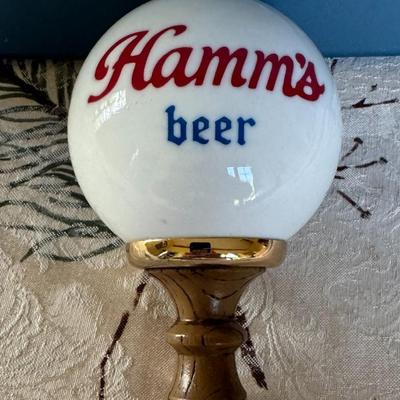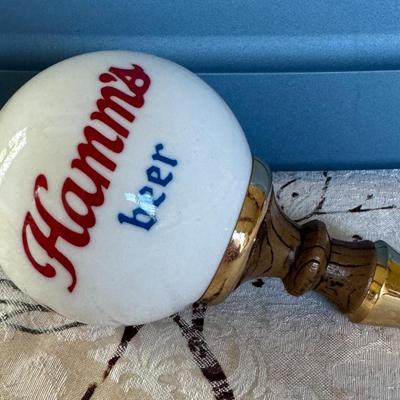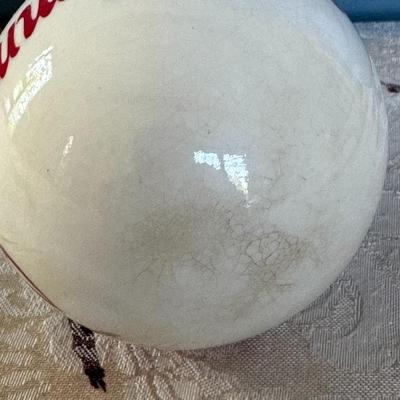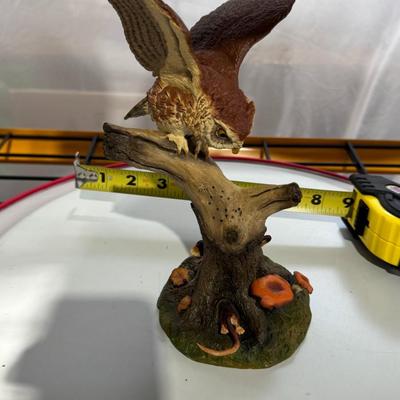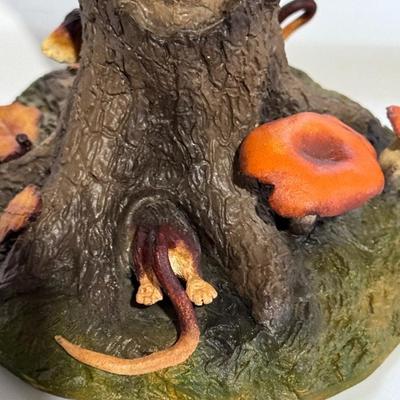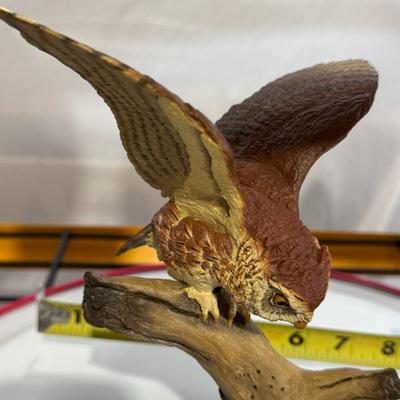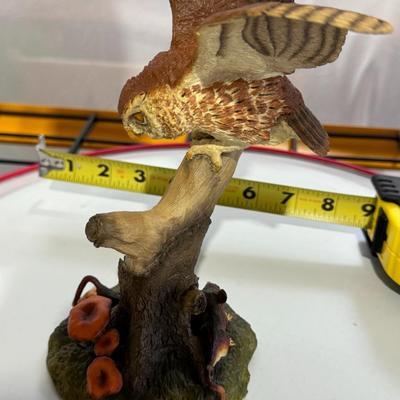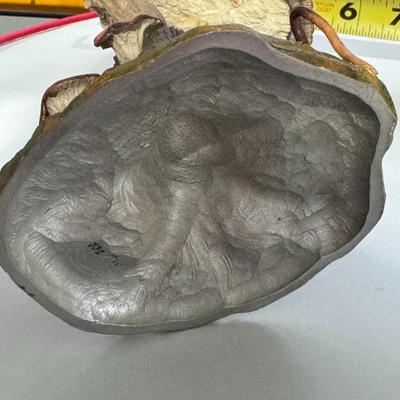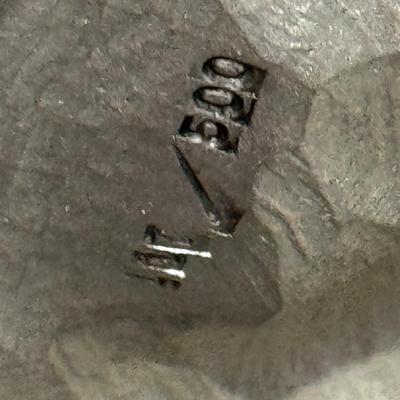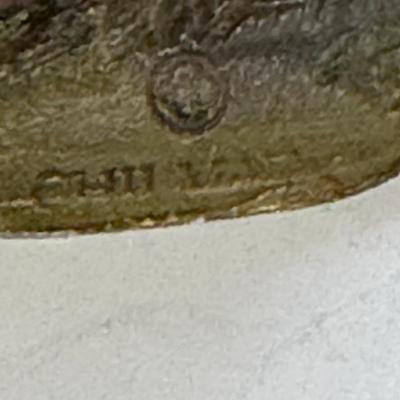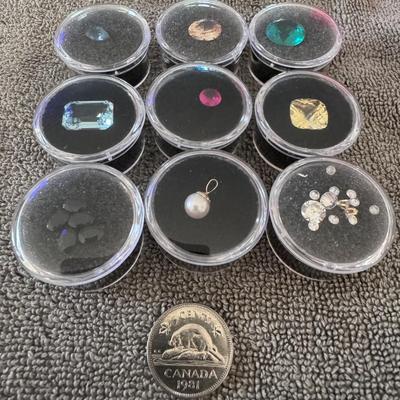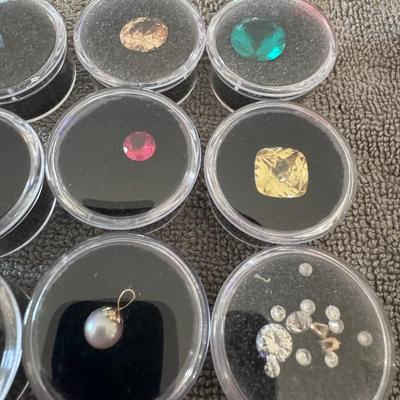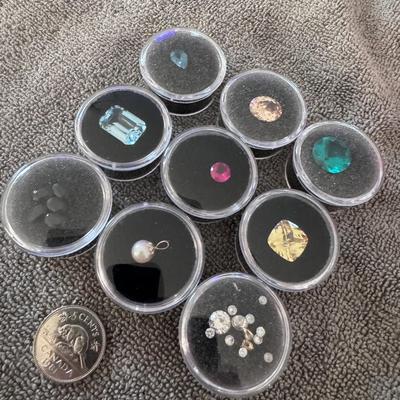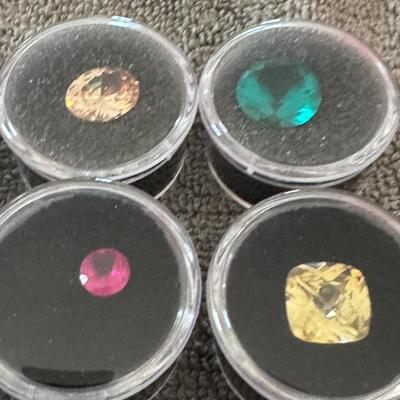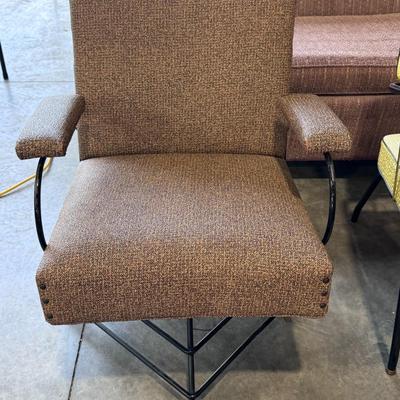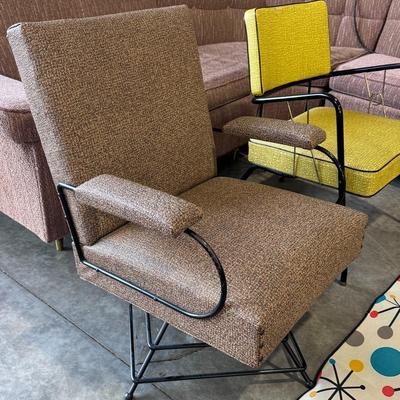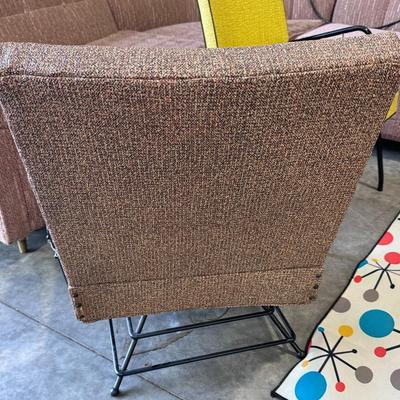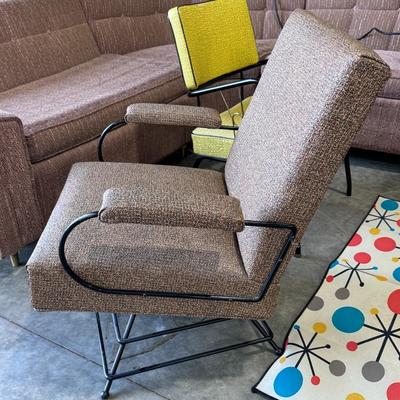-
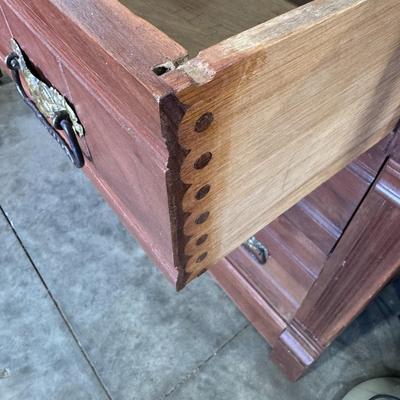
Step back in time with this Vintage Primitive 19th Century Cabinet, a true relic of early craftsmanship. Its rustic, weathered wood and simple, functional design capture the charm of a bygone era. Perfect for adding character to farmhouse, cottage, or eclectic interiors, this cabinet features ample storage with a time-worn patina that tells its own story. A unique piece that brings authenticity and history to your space, it's ideal for those who appreciate the beauty of primitive, handmade furniture. Dimensions: Height: 92 in (233.68 cm)Width: 53.25 in (135.26 cm)Depth: 23.25 in (59.06 cm) Style: Rustic (In the Style Of) Materials and Techniques: Glass,Wood Place of Origin: United States Period: Late 19th Century 101 / 1369 -
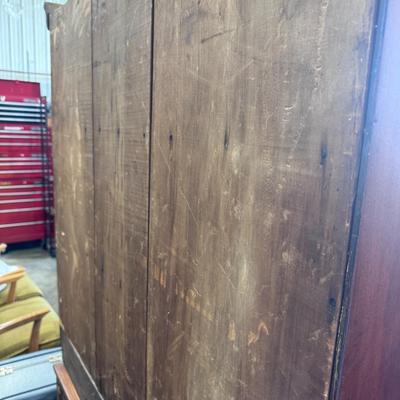
Step back in time with this Vintage Primitive 19th Century Cabinet, a true relic of early craftsmanship. Its rustic, weathered wood and simple, functional design capture the charm of a bygone era. Perfect for adding character to farmhouse, cottage, or eclectic interiors, this cabinet features ample storage with a time-worn patina that tells its own story. A unique piece that brings authenticity and history to your space, it's ideal for those who appreciate the beauty of primitive, handmade furniture. Dimensions: Height: 92 in (233.68 cm)Width: 53.25 in (135.26 cm)Depth: 23.25 in (59.06 cm) Style: Rustic (In the Style Of) Materials and Techniques: Glass,Wood Place of Origin: United States Period: Late 19th Century 102 / 1369 -
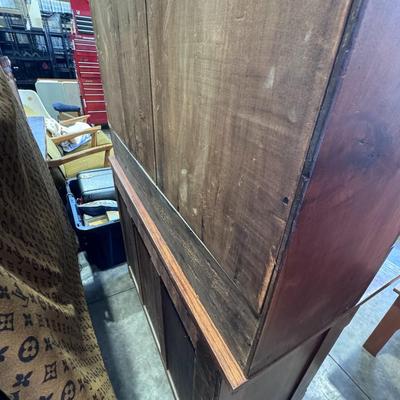
Step back in time with this Vintage Primitive 19th Century Cabinet, a true relic of early craftsmanship. Its rustic, weathered wood and simple, functional design capture the charm of a bygone era. Perfect for adding character to farmhouse, cottage, or eclectic interiors, this cabinet features ample storage with a time-worn patina that tells its own story. A unique piece that brings authenticity and history to your space, it's ideal for those who appreciate the beauty of primitive, handmade furniture. Dimensions: Height: 92 in (233.68 cm)Width: 53.25 in (135.26 cm)Depth: 23.25 in (59.06 cm) Style: Rustic (In the Style Of) Materials and Techniques: Glass,Wood Place of Origin: United States Period: Late 19th Century 103 / 1369 -
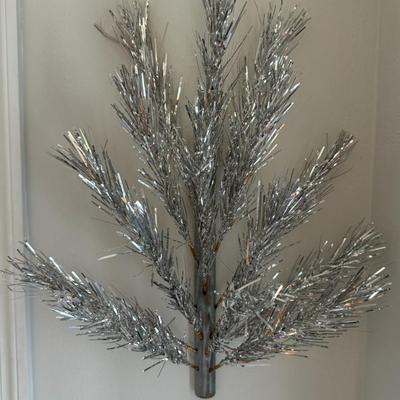
vintage "The Holiday" brand aluminum wall or door hanging Christmas tree, specifically Model K2000. Here's a summary of the item: Product: A vintage "The Holiday" aluminum Christmas tree designed to be hung on a wall or door, saving floor space. Model: K2000. Features: Branches packed in reusable storage tubes. Can be hung on any picture hook. Made from flame-proof aluminum, designed to last for years. Suitable for decorating like a full tree with lightweight ornaments. Era: These types of aluminum Christmas trees, including "The Holiday" brand, were popular during the mid-20th century, particularly in the 1950s and 60s. 104 / 1369 -
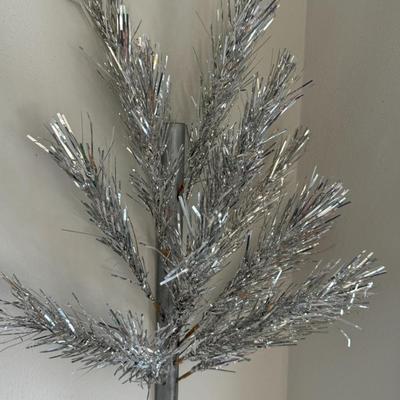
vintage "The Holiday" brand aluminum wall or door hanging Christmas tree, specifically Model K2000. Here's a summary of the item: Product: A vintage "The Holiday" aluminum Christmas tree designed to be hung on a wall or door, saving floor space. Model: K2000. Features: Branches packed in reusable storage tubes. Can be hung on any picture hook. Made from flame-proof aluminum, designed to last for years. Suitable for decorating like a full tree with lightweight ornaments. Era: These types of aluminum Christmas trees, including "The Holiday" brand, were popular during the mid-20th century, particularly in the 1950s and 60s. 105 / 1369 -
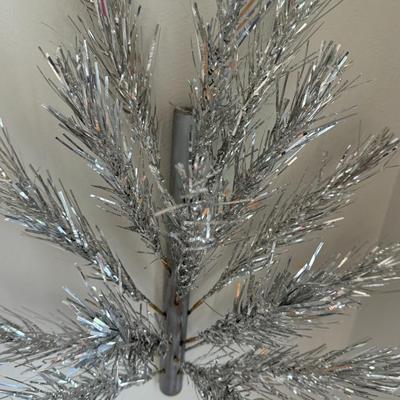
vintage "The Holiday" brand aluminum wall or door hanging Christmas tree, specifically Model K2000. Here's a summary of the item: Product: A vintage "The Holiday" aluminum Christmas tree designed to be hung on a wall or door, saving floor space. Model: K2000. Features: Branches packed in reusable storage tubes. Can be hung on any picture hook. Made from flame-proof aluminum, designed to last for years. Suitable for decorating like a full tree with lightweight ornaments. Era: These types of aluminum Christmas trees, including "The Holiday" brand, were popular during the mid-20th century, particularly in the 1950s and 60s. 106 / 1369 -
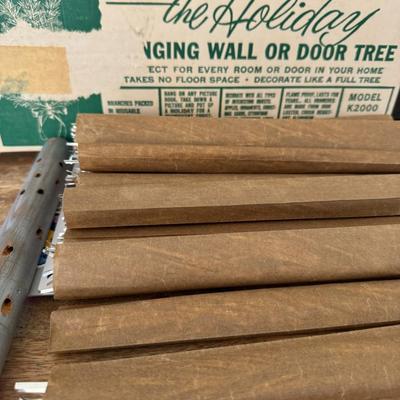
vintage "The Holiday" brand aluminum wall or door hanging Christmas tree, specifically Model K2000. Here's a summary of the item: Product: A vintage "The Holiday" aluminum Christmas tree designed to be hung on a wall or door, saving floor space. Model: K2000. Features: Branches packed in reusable storage tubes. Can be hung on any picture hook. Made from flame-proof aluminum, designed to last for years. Suitable for decorating like a full tree with lightweight ornaments. Era: These types of aluminum Christmas trees, including "The Holiday" brand, were popular during the mid-20th century, particularly in the 1950s and 60s. 107 / 1369 -
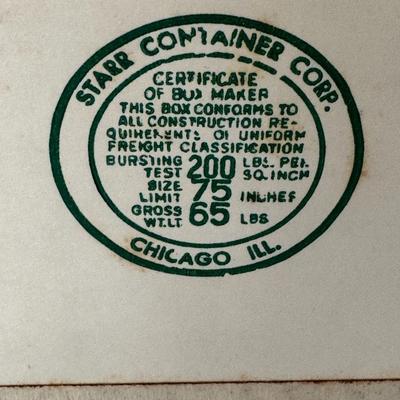
vintage "The Holiday" brand aluminum wall or door hanging Christmas tree, specifically Model K2000. Here's a summary of the item: Product: A vintage "The Holiday" aluminum Christmas tree designed to be hung on a wall or door, saving floor space. Model: K2000. Features: Branches packed in reusable storage tubes. Can be hung on any picture hook. Made from flame-proof aluminum, designed to last for years. Suitable for decorating like a full tree with lightweight ornaments. Era: These types of aluminum Christmas trees, including "The Holiday" brand, were popular during the mid-20th century, particularly in the 1950s and 60s. 108 / 1369 -
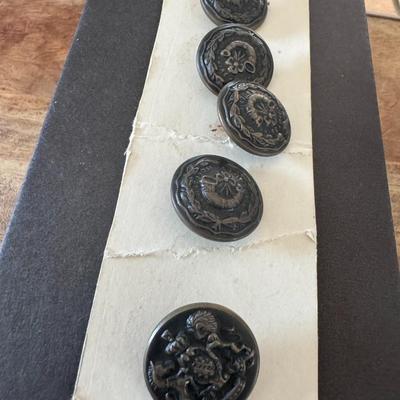
The button in the image is a vintage uniform button from the Oxfordshire and Buckinghamshire Light Infantry regiment of the British Army. Here's a breakdown of its identification: Regimental Affiliation: The button's design features elements characteristic of the Oxfordshire and Buckinghamshire Emblem: The visible emblem on the button, specifically a bugle horn, is a prominent symbol associated with light infantry regiments, including the Oxfordshire and Buckinghamshire Light Infantry, as seen on their uniform buttons and cap badges. Time Period: While exact dating can be challenging without further details like backmarks, similar buttons from this regiment are commonly identified as originating from the late 19th and early 20th centuries, particularly around the 1880s era based on search results. 109 / 1369 -
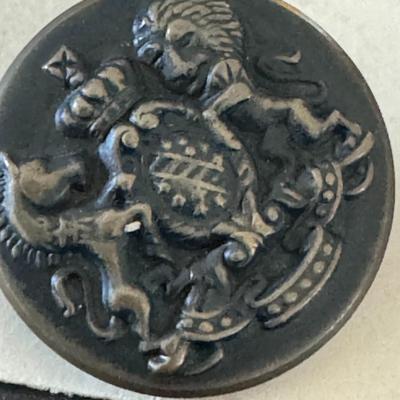
The button in the image is a vintage uniform button from the Oxfordshire and Buckinghamshire Light Infantry regiment of the British Army. Here's a breakdown of its identification: Regimental Affiliation: The button's design features elements characteristic of the Oxfordshire and Buckinghamshire Emblem: The visible emblem on the button, specifically a bugle horn, is a prominent symbol associated with light infantry regiments, including the Oxfordshire and Buckinghamshire Light Infantry, as seen on their uniform buttons and cap badges. Time Period: While exact dating can be challenging without further details like backmarks, similar buttons from this regiment are commonly identified as originating from the late 19th and early 20th centuries, particularly around the 1880s era based on search results. 110 / 1369 -
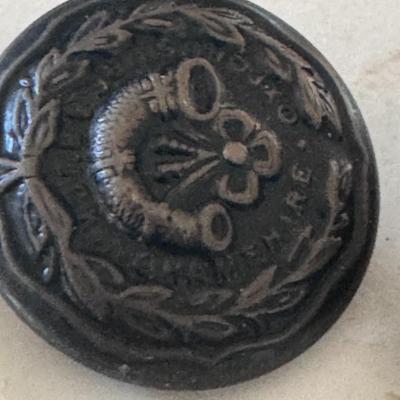
The button in the image is a vintage uniform button from the Oxfordshire and Buckinghamshire Light Infantry regiment of the British Army. Here's a breakdown of its identification: Regimental Affiliation: The button's design features elements characteristic of the Oxfordshire and Buckinghamshire Emblem: The visible emblem on the button, specifically a bugle horn, is a prominent symbol associated with light infantry regiments, including the Oxfordshire and Buckinghamshire Light Infantry, as seen on their uniform buttons and cap badges. Time Period: While exact dating can be challenging without further details like backmarks, similar buttons from this regiment are commonly identified as originating from the late 19th and early 20th centuries, particularly around the 1880s era based on search results. 111 / 1369 -
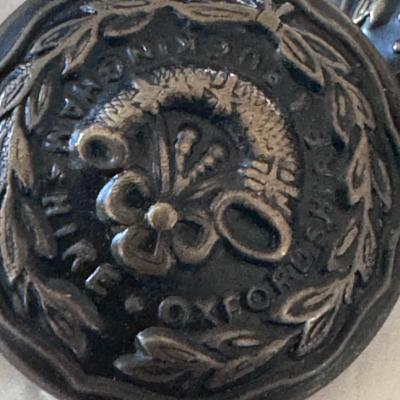
The button in the image is a vintage uniform button from the Oxfordshire and Buckinghamshire Light Infantry regiment of the British Army. Here's a breakdown of its identification: Regimental Affiliation: The button's design features elements characteristic of the Oxfordshire and Buckinghamshire Emblem: The visible emblem on the button, specifically a bugle horn, is a prominent symbol associated with light infantry regiments, including the Oxfordshire and Buckinghamshire Light Infantry, as seen on their uniform buttons and cap badges. Time Period: While exact dating can be challenging without further details like backmarks, similar buttons from this regiment are commonly identified as originating from the late 19th and early 20th centuries, particularly around the 1880s era based on search results. 112 / 1369 -
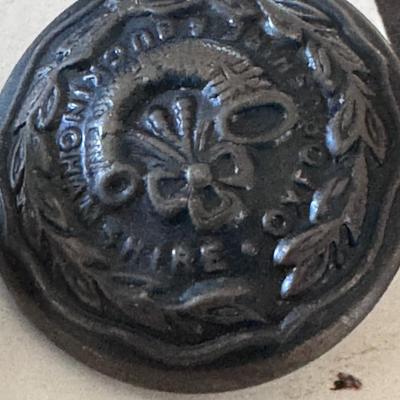
The button in the image is a vintage uniform button from the Oxfordshire and Buckinghamshire Light Infantry regiment of the British Army. Here's a breakdown of its identification: Regimental Affiliation: The button's design features elements characteristic of the Oxfordshire and Buckinghamshire Emblem: The visible emblem on the button, specifically a bugle horn, is a prominent symbol associated with light infantry regiments, including the Oxfordshire and Buckinghamshire Light Infantry, as seen on their uniform buttons and cap badges. Time Period: While exact dating can be challenging without further details like backmarks, similar buttons from this regiment are commonly identified as originating from the late 19th and early 20th centuries, particularly around the 1880s era based on search results. 113 / 1369 -
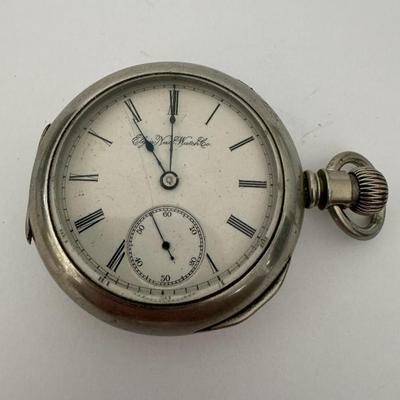
Vintage Elgin National Watch Co. Sidewinder Pocket Watch. Here's some information about this type of watch: Sidewinder Design: This term refers to the unusual placement of the winding stem at the 3 o'clock position on the side of the watch case, instead of the more common 12 o'clock position found in open-face watches or the hunter-case watches for which these movements were originally designed. Origin: Many "sidewinder" Elgin pocket watches originally housed movements intended for hunter-case watches, but these movements were later placed into open-face cases, resulting in the distinctive side-winding configuration. Features: These watches typically feature mechanical (manual) movements, a separate sub-dial for the seconds hand (usually at the 6 o'clock position), and various case materials like silveroid or gold-filled. Collectibility: Elgin pocket watches, including sidewinders, are valued for their historical significance, craftsmanship, and intricate designs, especially those with jeweled movements and fine finishes. Age: Based on historical information, many Elgin sidewinder pocket watches date back to the late 19th and early 20th centuries, with examples from the 1880s, 1890s, and early 1900s 114 / 1369 -
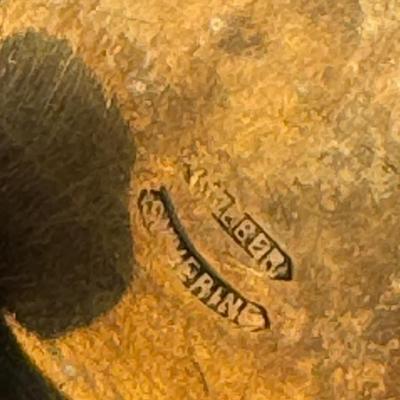
Vintage Elgin National Watch Co. Sidewinder Pocket Watch. Here's some information about this type of watch: Sidewinder Design: This term refers to the unusual placement of the winding stem at the 3 o'clock position on the side of the watch case, instead of the more common 12 o'clock position found in open-face watches or the hunter-case watches for which these movements were originally designed. Origin: Many "sidewinder" Elgin pocket watches originally housed movements intended for hunter-case watches, but these movements were later placed into open-face cases, resulting in the distinctive side-winding configuration. Features: These watches typically feature mechanical (manual) movements, a separate sub-dial for the seconds hand (usually at the 6 o'clock position), and various case materials like silveroid or gold-filled. Collectibility: Elgin pocket watches, including sidewinders, are valued for their historical significance, craftsmanship, and intricate designs, especially those with jeweled movements and fine finishes. Age: Based on historical information, many Elgin sidewinder pocket watches date back to the late 19th and early 20th centuries, with examples from the 1880s, 1890s, and early 1900s 115 / 1369 -
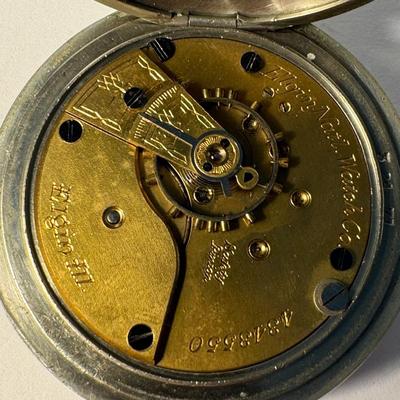
Vintage Elgin National Watch Co. Sidewinder Pocket Watch. Here's some information about this type of watch: Sidewinder Design: This term refers to the unusual placement of the winding stem at the 3 o'clock position on the side of the watch case, instead of the more common 12 o'clock position found in open-face watches or the hunter-case watches for which these movements were originally designed. Origin: Many "sidewinder" Elgin pocket watches originally housed movements intended for hunter-case watches, but these movements were later placed into open-face cases, resulting in the distinctive side-winding configuration. Features: These watches typically feature mechanical (manual) movements, a separate sub-dial for the seconds hand (usually at the 6 o'clock position), and various case materials like silveroid or gold-filled. Collectibility: Elgin pocket watches, including sidewinders, are valued for their historical significance, craftsmanship, and intricate designs, especially those with jeweled movements and fine finishes. Age: Based on historical information, many Elgin sidewinder pocket watches date back to the late 19th and early 20th centuries, with examples from the 1880s, 1890s, and early 1900s 116 / 1369 -
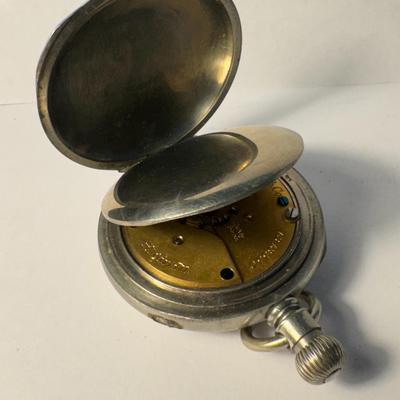
Vintage Elgin National Watch Co. Sidewinder Pocket Watch. Here's some information about this type of watch: Sidewinder Design: This term refers to the unusual placement of the winding stem at the 3 o'clock position on the side of the watch case, instead of the more common 12 o'clock position found in open-face watches or the hunter-case watches for which these movements were originally designed. Origin: Many "sidewinder" Elgin pocket watches originally housed movements intended for hunter-case watches, but these movements were later placed into open-face cases, resulting in the distinctive side-winding configuration. Features: These watches typically feature mechanical (manual) movements, a separate sub-dial for the seconds hand (usually at the 6 o'clock position), and various case materials like silveroid or gold-filled. Collectibility: Elgin pocket watches, including sidewinders, are valued for their historical significance, craftsmanship, and intricate designs, especially those with jeweled movements and fine finishes. Age: Based on historical information, many Elgin sidewinder pocket watches date back to the late 19th and early 20th centuries, with examples from the 1880s, 1890s, and early 1900s 117 / 1369 -
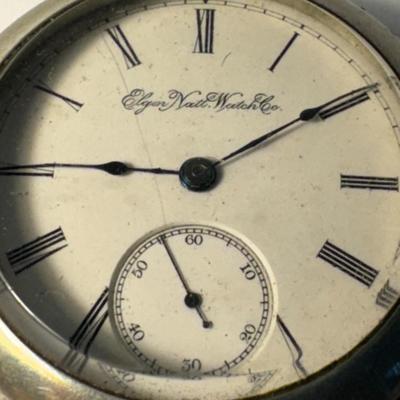
Vintage Elgin National Watch Co. Sidewinder Pocket Watch. Here's some information about this type of watch: Sidewinder Design: This term refers to the unusual placement of the winding stem at the 3 o'clock position on the side of the watch case, instead of the more common 12 o'clock position found in open-face watches or the hunter-case watches for which these movements were originally designed. Origin: Many "sidewinder" Elgin pocket watches originally housed movements intended for hunter-case watches, but these movements were later placed into open-face cases, resulting in the distinctive side-winding configuration. Features: These watches typically feature mechanical (manual) movements, a separate sub-dial for the seconds hand (usually at the 6 o'clock position), and various case materials like silveroid or gold-filled. Collectibility: Elgin pocket watches, including sidewinders, are valued for their historical significance, craftsmanship, and intricate designs, especially those with jeweled movements and fine finishes. Age: Based on historical information, many Elgin sidewinder pocket watches date back to the late 19th and early 20th centuries, with examples from the 1880s, 1890s, and early 1900s 118 / 1369 -
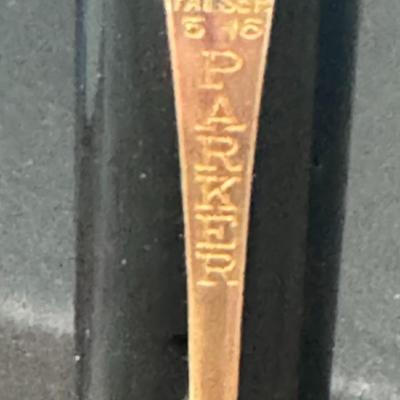
Parker fountain pen, likely from the mid-20th century. Here's what can be inferred about the pen: Brand and Model: The presence of "PARKER" engraved on the clip strongly indicates it's a Parker pen. Based on its streamlined black barrel and gold-toned clip and cap band, it closely resembles models like the Parker Duofold Streamline or potentially an early Parker 51, particularly those with a more visible cap band. Era: The design elements, especially the clip and general aesthetic, are consistent with Parker pens produced in the 1930s or 1940s, a period when models like the Duofold and 51 were prominent. 119 / 1369 -
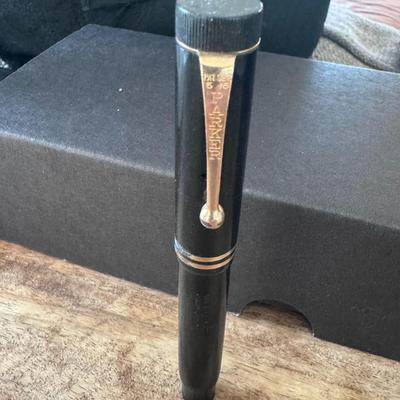
Parker fountain pen, likely from the mid-20th century. Here's what can be inferred about the pen: Brand and Model: The presence of "PARKER" engraved on the clip strongly indicates it's a Parker pen. Based on its streamlined black barrel and gold-toned clip and cap band, it closely resembles models like the Parker Duofold Streamline or potentially an early Parker 51, particularly those with a more visible cap band. Era: The design elements, especially the clip and general aesthetic, are consistent with Parker pens produced in the 1930s or 1940s, a period when models like the Duofold and 51 were prominent. 120 / 1369 -
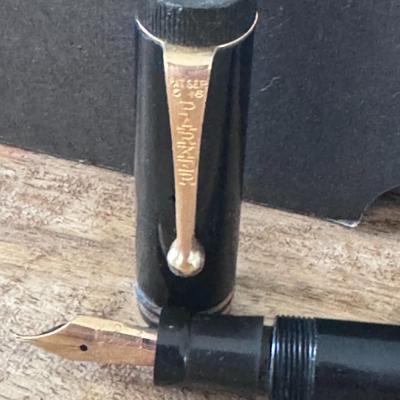
Parker fountain pen, likely from the mid-20th century. Here's what can be inferred about the pen: Brand and Model: The presence of "PARKER" engraved on the clip strongly indicates it's a Parker pen. Based on its streamlined black barrel and gold-toned clip and cap band, it closely resembles models like the Parker Duofold Streamline or potentially an early Parker 51, particularly those with a more visible cap band. Era: The design elements, especially the clip and general aesthetic, are consistent with Parker pens produced in the 1930s or 1940s, a period when models like the Duofold and 51 were prominent. 121 / 1369 -
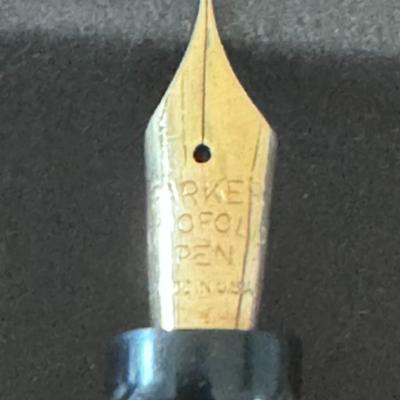
Parker fountain pen, likely from the mid-20th century. Here's what can be inferred about the pen: Brand and Model: The presence of "PARKER" engraved on the clip strongly indicates it's a Parker pen. Based on its streamlined black barrel and gold-toned clip and cap band, it closely resembles models like the Parker Duofold Streamline or potentially an early Parker 51, particularly those with a more visible cap band. Era: The design elements, especially the clip and general aesthetic, are consistent with Parker pens produced in the 1930s or 1940s, a period when models like the Duofold and 51 were prominent. 122 / 1369 -
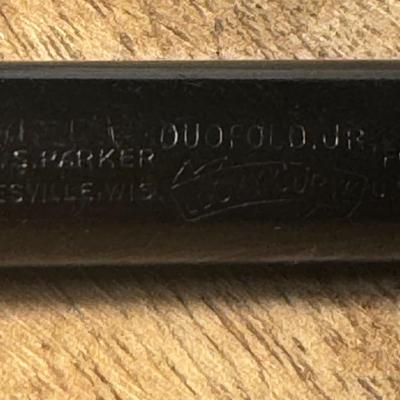
Parker fountain pen, likely from the mid-20th century. Here's what can be inferred about the pen: Brand and Model: The presence of "PARKER" engraved on the clip strongly indicates it's a Parker pen. Based on its streamlined black barrel and gold-toned clip and cap band, it closely resembles models like the Parker Duofold Streamline or potentially an early Parker 51, particularly those with a more visible cap band. Era: The design elements, especially the clip and general aesthetic, are consistent with Parker pens produced in the 1930s or 1940s, a period when models like the Duofold and 51 were prominent. 123 / 1369 -
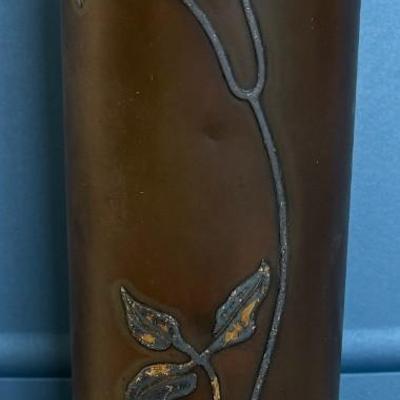
Early Heintz Art Metal Shop Sterling on Bronze Rolled Top Vase. This type of vase is a hallmark of the Arts and Crafts movement, known for its intricate sterling silver overlay designs on bronze. Heintz Art Metal Shop was known for developing a unique method of attaching sterling silver to bronze without solder, a process patented in 1912. Key Features: Material: Bronze with sterling silver overlay. Design: Arts and Crafts style, featuring naturalistic floral motifs. Manufacturing Technique: Forms were "spun" on a metal lathe and patinated to achieve a distinctive finish. Era: Early 20th century. 124 / 1369 -
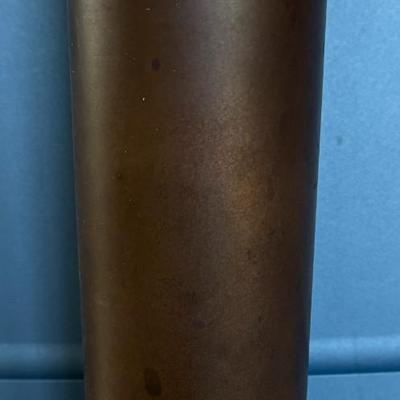
Early Heintz Art Metal Shop Sterling on Bronze Rolled Top Vase. This type of vase is a hallmark of the Arts and Crafts movement, known for its intricate sterling silver overlay designs on bronze. Heintz Art Metal Shop was known for developing a unique method of attaching sterling silver to bronze without solder, a process patented in 1912. Key Features: Material: Bronze with sterling silver overlay. Design: Arts and Crafts style, featuring naturalistic floral motifs. Manufacturing Technique: Forms were "spun" on a metal lathe and patinated to achieve a distinctive finish. Era: Early 20th century. 125 / 1369 -
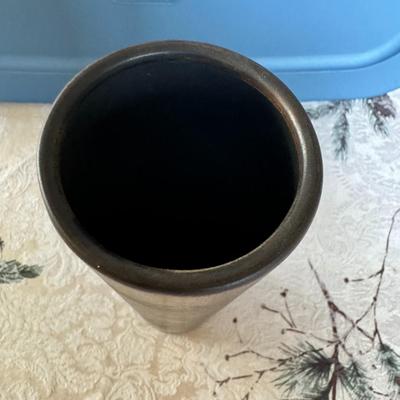
Early Heintz Art Metal Shop Sterling on Bronze Rolled Top Vase. This type of vase is a hallmark of the Arts and Crafts movement, known for its intricate sterling silver overlay designs on bronze. Heintz Art Metal Shop was known for developing a unique method of attaching sterling silver to bronze without solder, a process patented in 1912. Key Features: Material: Bronze with sterling silver overlay. Design: Arts and Crafts style, featuring naturalistic floral motifs. Manufacturing Technique: Forms were "spun" on a metal lathe and patinated to achieve a distinctive finish. Era: Early 20th century. 126 / 1369 -
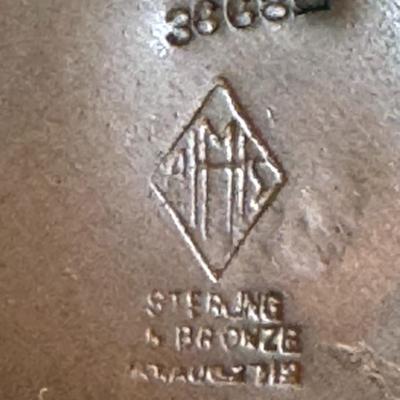
Early Heintz Art Metal Shop Sterling on Bronze Rolled Top Vase. This type of vase is a hallmark of the Arts and Crafts movement, known for its intricate sterling silver overlay designs on bronze. Heintz Art Metal Shop was known for developing a unique method of attaching sterling silver to bronze without solder, a process patented in 1912. Key Features: Material: Bronze with sterling silver overlay. Design: Arts and Crafts style, featuring naturalistic floral motifs. Manufacturing Technique: Forms were "spun" on a metal lathe and patinated to achieve a distinctive finish. Era: Early 20th century. 127 / 1369 -
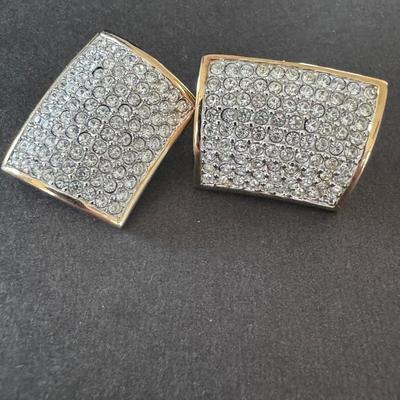
Vintage Swarovski Pave Faux Diamond Gold Tone Clip On Earrings. Here's more information about these types of earrings: Design & Material: These earrings feature a gold-tone base densely embellished with numerous clear Swarovski crystals in a pave setting, mimicking the look of diamonds. The design often involves a curved or rectangular shape, and the crystals are known for their clarity and brilliance, typical of Swarovski products. Type: They are specifically clip-on earrings, designed for individuals without pierced ears or those who prefer the comfort and ease of clip-on styles. 128 / 1369 -
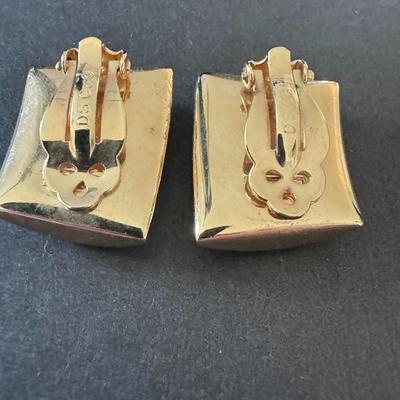
Vintage Swarovski Pave Faux Diamond Gold Tone Clip On Earrings. Here's more information about these types of earrings: Design & Material: These earrings feature a gold-tone base densely embellished with numerous clear Swarovski crystals in a pave setting, mimicking the look of diamonds. The design often involves a curved or rectangular shape, and the crystals are known for their clarity and brilliance, typical of Swarovski products. Type: They are specifically clip-on earrings, designed for individuals without pierced ears or those who prefer the comfort and ease of clip-on styles. 129 / 1369 -
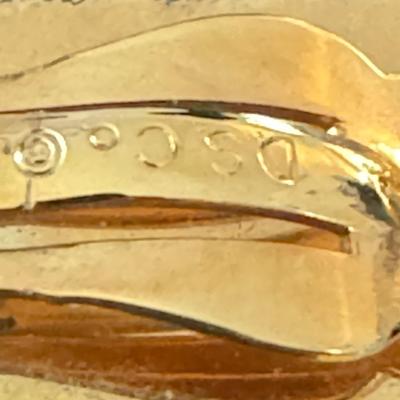
Vintage Swarovski Pave Faux Diamond Gold Tone Clip On Earrings. Here's more information about these types of earrings: Design & Material: These earrings feature a gold-tone base densely embellished with numerous clear Swarovski crystals in a pave setting, mimicking the look of diamonds. The design often involves a curved or rectangular shape, and the crystals are known for their clarity and brilliance, typical of Swarovski products. Type: They are specifically clip-on earrings, designed for individuals without pierced ears or those who prefer the comfort and ease of clip-on styles. 130 / 1369 -
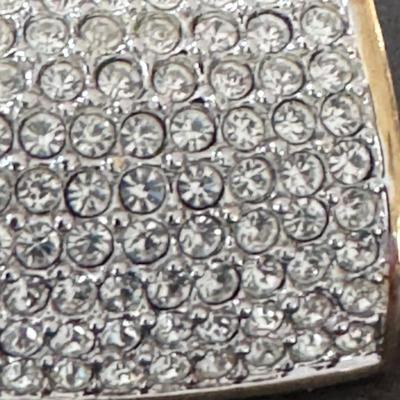
Vintage Swarovski Pave Faux Diamond Gold Tone Clip On Earrings. Here's more information about these types of earrings: Design & Material: These earrings feature a gold-tone base densely embellished with numerous clear Swarovski crystals in a pave setting, mimicking the look of diamonds. The design often involves a curved or rectangular shape, and the crystals are known for their clarity and brilliance, typical of Swarovski products. Type: They are specifically clip-on earrings, designed for individuals without pierced ears or those who prefer the comfort and ease of clip-on styles. 131 / 1369 -
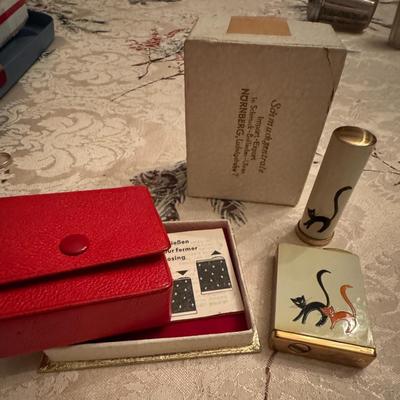
The beige box's text reads: "Schmuckzentrale Import-Export in Schmuck-Brillanten-Uhren NORNBERG, Ludwigstraße 7"This translates to "Jewelry Center Import-Export in Jewelry, Diamonds, Watches NUREMBERG, Ludwigstrasse 7" The metal holders likely held lipstick or a compact mirror based on their shape and decorative design Based on the information, the item is likely a vintage lipstick holder or compact mirror set, possibly from Germany, given the text and location While there are many jewelry shops listed in Nuremberg, and some specific listings for vintage lipstick holders, there's no direct information about the specific maker or origin of the cat design. You might find more details by researching "Schmuckzentrale NORNBERG Ludwigstraße 7" specifically, 132 / 1369 -
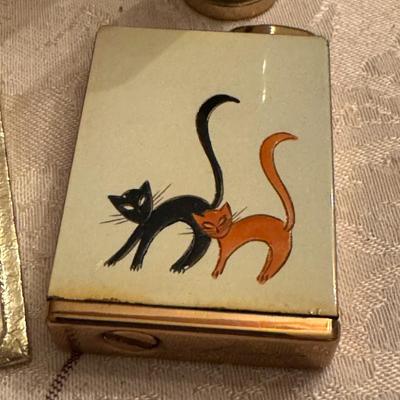
The beige box's text reads: "Schmuckzentrale Import-Export in Schmuck-Brillanten-Uhren NORNBERG, Ludwigstraße 7"This translates to "Jewelry Center Import-Export in Jewelry, Diamonds, Watches NUREMBERG, Ludwigstrasse 7" The metal holders likely held lipstick or a compact mirror based on their shape and decorative design Based on the information, the item is likely a vintage lipstick holder or compact mirror set, possibly from Germany, given the text and location While there are many jewelry shops listed in Nuremberg, and some specific listings for vintage lipstick holders, there's no direct information about the specific maker or origin of the cat design. You might find more details by researching "Schmuckzentrale NORNBERG Ludwigstraße 7" specifically, 133 / 1369 -
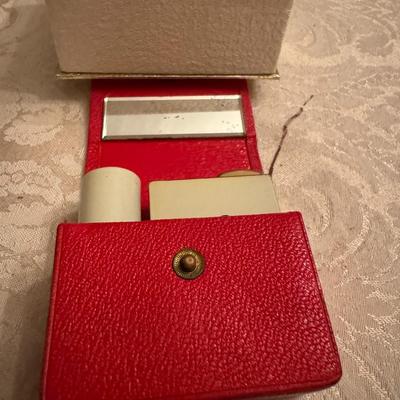
The beige box's text reads: "Schmuckzentrale Import-Export in Schmuck-Brillanten-Uhren NORNBERG, Ludwigstraße 7"This translates to "Jewelry Center Import-Export in Jewelry, Diamonds, Watches NUREMBERG, Ludwigstrasse 7" The metal holders likely held lipstick or a compact mirror based on their shape and decorative design Based on the information, the item is likely a vintage lipstick holder or compact mirror set, possibly from Germany, given the text and location While there are many jewelry shops listed in Nuremberg, and some specific listings for vintage lipstick holders, there's no direct information about the specific maker or origin of the cat design. You might find more details by researching "Schmuckzentrale NORNBERG Ludwigstraße 7" specifically, 134 / 1369 -
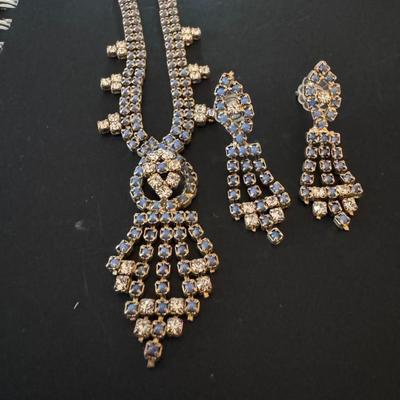
vintage necklace and matching earrings set, featuring blue and white stones, likely designed for cocktail wear or historical reenactments. Here's more information about this type of jewelry: Paste Jewelry: This refers to costume jewelry made with high-quality, hand-cut leaded glass that is polished to achieve a brilliance similar to gemstones. It emerged as a popular and more affordable alternative to diamonds and other precious stones, particularly in the Georgian era (mid-1700s to 1930s). Design and Era: The intricate design with blue and white stones suggests a potential Art Deco influence (1920s-1930s) or even earlier periods like the Georgian or Victorian eras, where paste jewelry was highly fashionable. Reenactment or Cocktail Wear: The description "Reenactment Cocktail" suggests its suitability for period costumes in historical reenactments or as a stylish statement piece for special occasions and cocktail parties. 135 / 1369 -
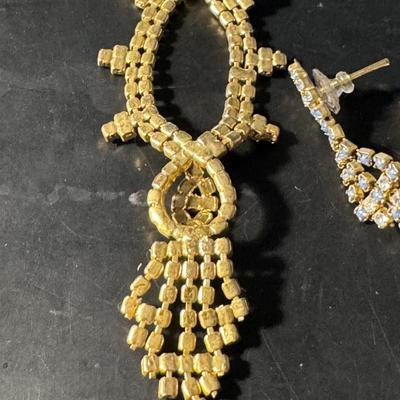
vintage necklace and matching earrings set, featuring blue and white stones, likely designed for cocktail wear or historical reenactments. Here's more information about this type of jewelry: Paste Jewelry: This refers to costume jewelry made with high-quality, hand-cut leaded glass that is polished to achieve a brilliance similar to gemstones. It emerged as a popular and more affordable alternative to diamonds and other precious stones, particularly in the Georgian era (mid-1700s to 1930s). Design and Era: The intricate design with blue and white stones suggests a potential Art Deco influence (1920s-1930s) or even earlier periods like the Georgian or Victorian eras, where paste jewelry was highly fashionable. Reenactment or Cocktail Wear: The description "Reenactment Cocktail" suggests its suitability for period costumes in historical reenactments or as a stylish statement piece for special occasions and cocktail parties. 136 / 1369 -
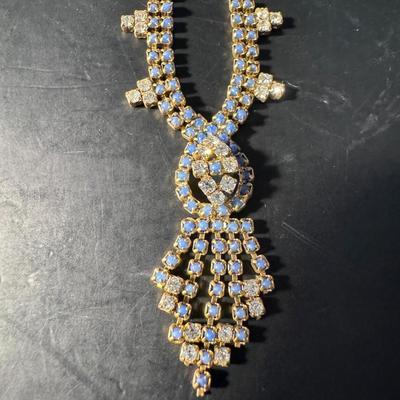
vintage necklace and matching earrings set, featuring blue and white stones, likely designed for cocktail wear or historical reenactments. Here's more information about this type of jewelry: Paste Jewelry: This refers to costume jewelry made with high-quality, hand-cut leaded glass that is polished to achieve a brilliance similar to gemstones. It emerged as a popular and more affordable alternative to diamonds and other precious stones, particularly in the Georgian era (mid-1700s to 1930s). Design and Era: The intricate design with blue and white stones suggests a potential Art Deco influence (1920s-1930s) or even earlier periods like the Georgian or Victorian eras, where paste jewelry was highly fashionable. Reenactment or Cocktail Wear: The description "Reenactment Cocktail" suggests its suitability for period costumes in historical reenactments or as a stylish statement piece for special occasions and cocktail parties. 137 / 1369 -
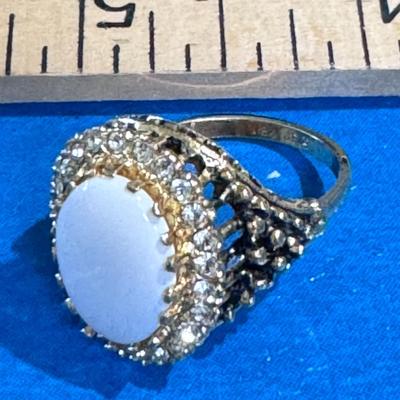
vintage or antique cocktail ring featuring a prominent white cabochon center stone in an ornate, gold-toned setting. Here's a closer look at its potential characteristics: Style: The intricate metalwork, possibly filigree, and the overall design suggest an Edwardian or Art Deco influence, popular styles in the early 20th century known for their delicate details and emphasis on white gemstones and metals. Center Stone: The large, smooth, oval, white stone is a cabochon cut, a common style for translucent or opaque gemstones. It is likely either a white opal (known for its play-of-color, though not always visible in still images) or a moonstone (valued for its adularescence or Schiller's Effect, a subtle, reflective sheen). While coral and jade were mentioned in initial searches, the smooth, possibly luminous appearance points more towards opal or moonstone. Accent Stones: The smaller, clear stones surrounding the center cabochon form a halo setting, enhancing the main stone's presence. 141 / 1369 -
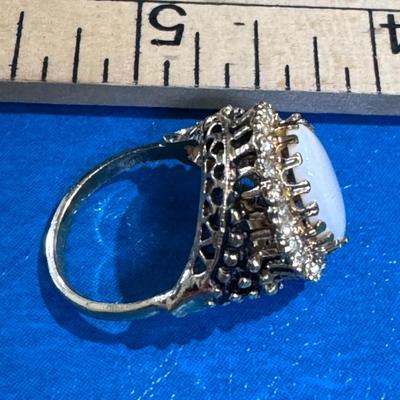
vintage or antique cocktail ring featuring a prominent white cabochon center stone in an ornate, gold-toned setting. Here's a closer look at its potential characteristics: Style: The intricate metalwork, possibly filigree, and the overall design suggest an Edwardian or Art Deco influence, popular styles in the early 20th century known for their delicate details and emphasis on white gemstones and metals. Center Stone: The large, smooth, oval, white stone is a cabochon cut, a common style for translucent or opaque gemstones. It is likely either a white opal (known for its play-of-color, though not always visible in still images) or a moonstone (valued for its adularescence or Schiller's Effect, a subtle, reflective sheen). While coral and jade were mentioned in initial searches, the smooth, possibly luminous appearance points more towards opal or moonstone. Accent Stones: The smaller, clear stones surrounding the center cabochon form a halo setting, enhancing the main stone's presence. 142 / 1369 -
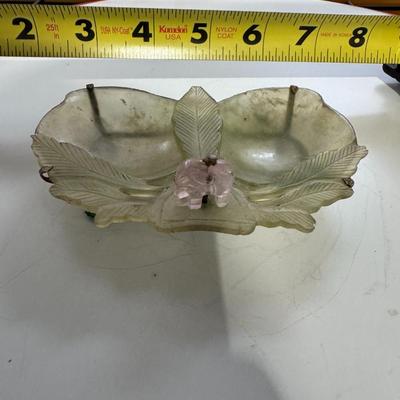
Fine example of carved jade / translucent 151 / 1369 -
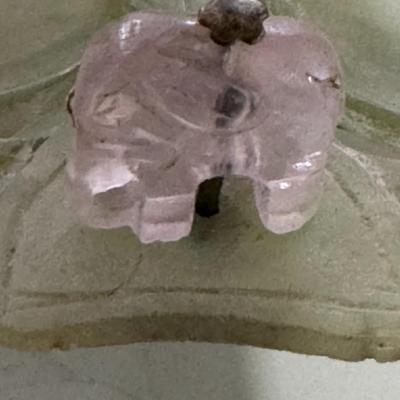
Fine example of carved jade / translucent 152 / 1369 -
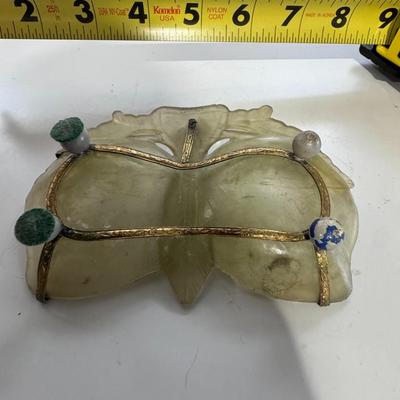
Fine example of carved jade / translucent 153 / 1369 -
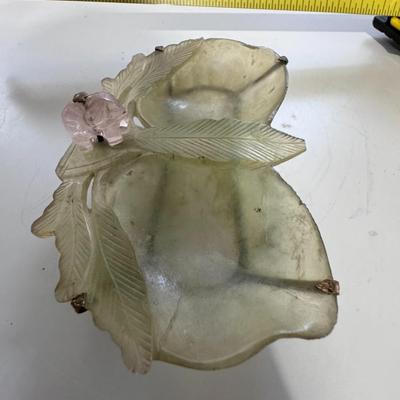
Fine example of carved jade / translucent 154 / 1369 -
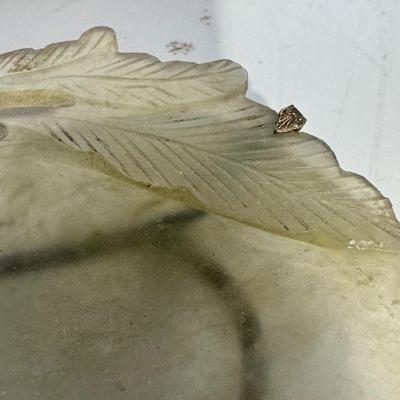
Fine example of carved jade / translucent 155 / 1369 -
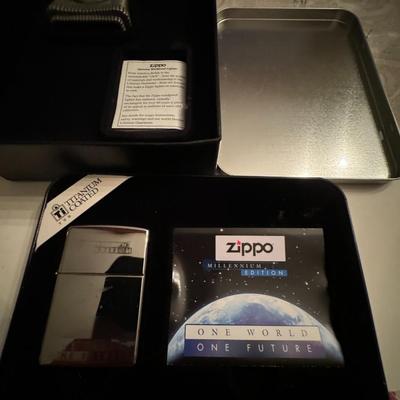
Zippo Millennium Edition lighter, featuring the design "One World... One Future". This Zippo lighter has the following characteristics: Millennium Edition: It is part of a series made to celebrate the millennium. "One World... One Future" Design: The design prominently features this phrase. Titanium Coated: The lighter has a durable titanium coating. Zippo states this was inspired by technology used on the Space Shuttle. Limited Production: The Millennium Edition was a limited release, with 100,000 produced worldwide, each with a unique bottom stamp. Computer Engraved: This edition was the first Zippo collectible with computer engraving. 156 / 1369 -

Zippo Millennium Edition lighter, featuring the design "One World... One Future". This Zippo lighter has the following characteristics: Millennium Edition: It is part of a series made to celebrate the millennium. "One World... One Future" Design: The design prominently features this phrase. Titanium Coated: The lighter has a durable titanium coating. Zippo states this was inspired by technology used on the Space Shuttle. Limited Production: The Millennium Edition was a limited release, with 100,000 produced worldwide, each with a unique bottom stamp. Computer Engraved: This edition was the first Zippo collectible with computer engraving. 157 / 1369 -
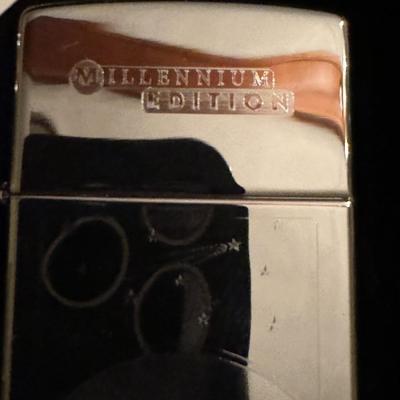
Zippo Millennium Edition lighter, featuring the design "One World... One Future". This Zippo lighter has the following characteristics: Millennium Edition: It is part of a series made to celebrate the millennium. "One World... One Future" Design: The design prominently features this phrase. Titanium Coated: The lighter has a durable titanium coating. Zippo states this was inspired by technology used on the Space Shuttle. Limited Production: The Millennium Edition was a limited release, with 100,000 produced worldwide, each with a unique bottom stamp. Computer Engraved: This edition was the first Zippo collectible with computer engraving. 158 / 1369 -
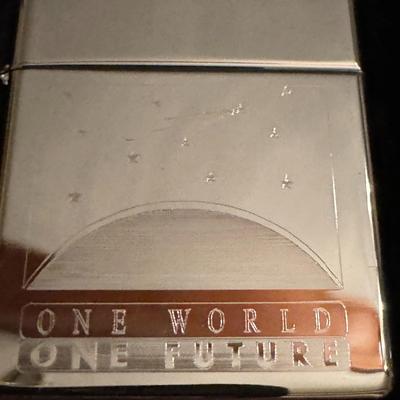
Zippo Millennium Edition lighter, featuring the design "One World... One Future". This Zippo lighter has the following characteristics: Millennium Edition: It is part of a series made to celebrate the millennium. "One World... One Future" Design: The design prominently features this phrase. Titanium Coated: The lighter has a durable titanium coating. Zippo states this was inspired by technology used on the Space Shuttle. Limited Production: The Millennium Edition was a limited release, with 100,000 produced worldwide, each with a unique bottom stamp. Computer Engraved: This edition was the first Zippo collectible with computer engraving. 159 / 1369 -
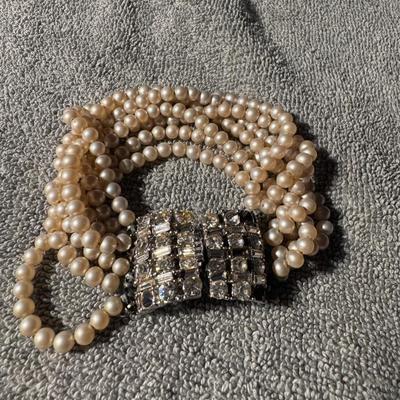
vintage Vendome costume jewelry, identifiable by the "Vendome" mark, typically found in an oval shape, as seen here. Here's some information about Vendome jewelry: Part of Coro Vendome was established as a superior, high-end line of the renowned American costume jewelry manufacturer, Coro, becoming more prominent in the 1950s. High-Quality Materials Vendome pieces were known for using high-quality imported materials, including European stones, faceted crystal beads, Lucite, and lustrous faux pearls, setting them apart in the costume jewelry market. Distinctive Designs The brand was recognized for its innovative and elegant designs, often featuring intricate details, rich enameling, and sometimes even moveable parts or adjustable clip backs on earrings. Collectible Value Vendome jewelry is highly collectible today, with certain elaborate or rare pieces, especially those designed by Helen Marion, potentially fetching significant values among collectors. 160 / 1369 -
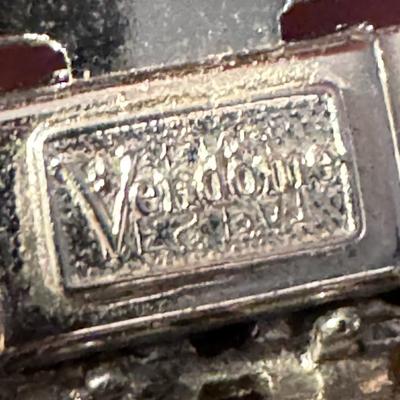
vintage Vendome costume jewelry, identifiable by the "Vendome" mark, typically found in an oval shape, as seen here. Here's some information about Vendome jewelry: Part of Coro Vendome was established as a superior, high-end line of the renowned American costume jewelry manufacturer, Coro, becoming more prominent in the 1950s. High-Quality Materials Vendome pieces were known for using high-quality imported materials, including European stones, faceted crystal beads, Lucite, and lustrous faux pearls, setting them apart in the costume jewelry market. Distinctive Designs The brand was recognized for its innovative and elegant designs, often featuring intricate details, rich enameling, and sometimes even moveable parts or adjustable clip backs on earrings. Collectible Value Vendome jewelry is highly collectible today, with certain elaborate or rare pieces, especially those designed by Helen Marion, potentially fetching significant values among collectors. 161 / 1369 -
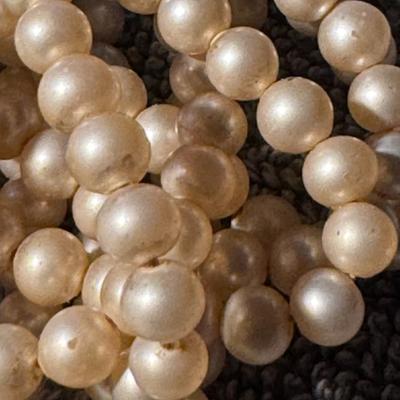
vintage Vendome costume jewelry, identifiable by the "Vendome" mark, typically found in an oval shape, as seen here. Here's some information about Vendome jewelry: Part of Coro Vendome was established as a superior, high-end line of the renowned American costume jewelry manufacturer, Coro, becoming more prominent in the 1950s. High-Quality Materials Vendome pieces were known for using high-quality imported materials, including European stones, faceted crystal beads, Lucite, and lustrous faux pearls, setting them apart in the costume jewelry market. Distinctive Designs The brand was recognized for its innovative and elegant designs, often featuring intricate details, rich enameling, and sometimes even moveable parts or adjustable clip backs on earrings. Collectible Value Vendome jewelry is highly collectible today, with certain elaborate or rare pieces, especially those designed by Helen Marion, potentially fetching significant values among collectors. 162 / 1369 -
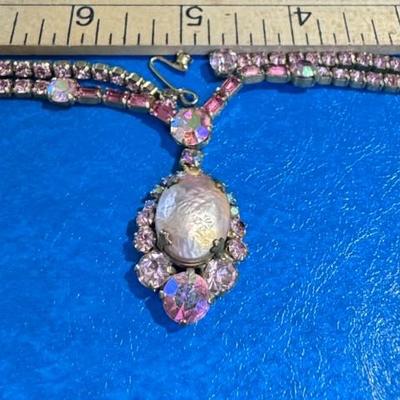
vintage-style necklace or pendant featuring a central faux baroque pearl surrounded by pink and iridescent rhinestones, likely set in a silver or gold-tone metal. This piece appears to be a form of costume jewelry, which was popular in the mid-20th century. Here's a breakdown of the item: Focal Point: The prominent feature is a large, irregularly shaped, off-white (or possibly pale pink) faux baroque pearl, giving it a classic and elegant feel. Embellishments: The pearl is accented by numerous smaller, faceted pink and iridescent "Aurora Borealis" rhinestones, which sparkle with various colors depending on the light. Era and Style: Based on the design and materials (faux pearls, prominent rhinestones), it strongly resembles styles prevalent in mid-century vintage costume jewelry, particularly from the 1950s or 1960s. 163 / 1369 -
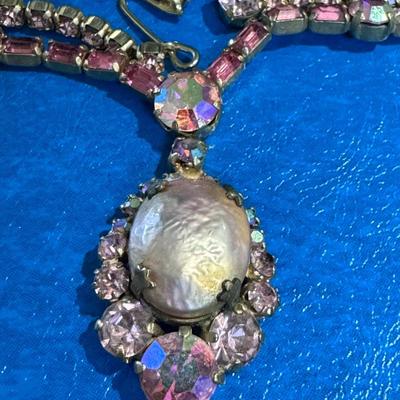
vintage-style necklace or pendant featuring a central faux baroque pearl surrounded by pink and iridescent rhinestones, likely set in a silver or gold-tone metal. This piece appears to be a form of costume jewelry, which was popular in the mid-20th century. Here's a breakdown of the item: Focal Point: The prominent feature is a large, irregularly shaped, off-white (or possibly pale pink) faux baroque pearl, giving it a classic and elegant feel. Embellishments: The pearl is accented by numerous smaller, faceted pink and iridescent "Aurora Borealis" rhinestones, which sparkle with various colors depending on the light. Era and Style: Based on the design and materials (faux pearls, prominent rhinestones), it strongly resembles styles prevalent in mid-century vintage costume jewelry, particularly from the 1950s or 1960s. 164 / 1369 -
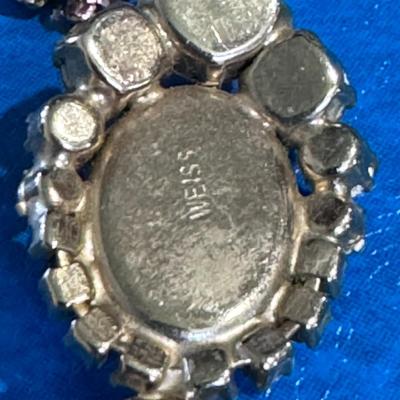
vintage-style necklace or pendant featuring a central faux baroque pearl surrounded by pink and iridescent rhinestones, likely set in a silver or gold-tone metal. This piece appears to be a form of costume jewelry, which was popular in the mid-20th century. Here's a breakdown of the item: Focal Point: The prominent feature is a large, irregularly shaped, off-white (or possibly pale pink) faux baroque pearl, giving it a classic and elegant feel. Embellishments: The pearl is accented by numerous smaller, faceted pink and iridescent "Aurora Borealis" rhinestones, which sparkle with various colors depending on the light. Era and Style: Based on the design and materials (faux pearls, prominent rhinestones), it strongly resembles styles prevalent in mid-century vintage costume jewelry, particularly from the 1950s or 1960s. 165 / 1369 -
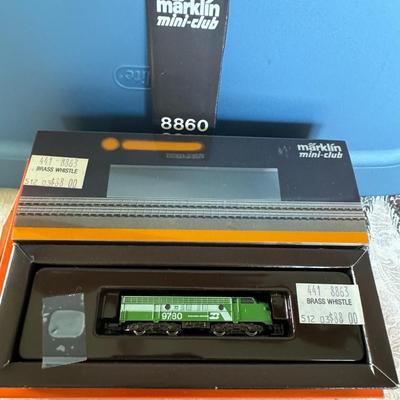
Märklin 8860 Z scale model train locomotive. It is part of the Märklin mini-club line. Märklin is a German model train manufacturer that introduced the Z scale (1:220) in 1972. Here's some additional information about the Märklin 8860: Type: Diesel locomotive, specifically a replica of an EMD F7. Road Name: Burlington Northern. Scale: Z gauge (1:220). Year Manufactured: 1990. Features: Light function and a Bo-Bo wheel configuration. Condition: excellent condition with the original box. It has been tested to run in both directions with a working headlight. Motor: Uses a 3-pole motor. Material: Made from a combination of plastic and diecast. Control System: Analog. 166 / 1369 -
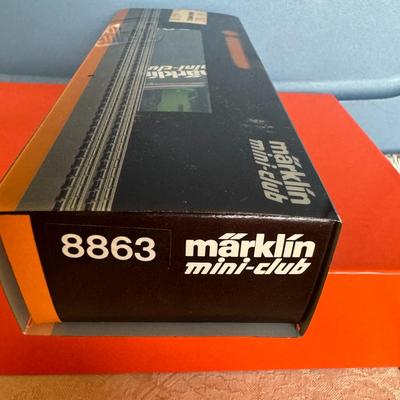
Märklin 8860 Z scale model train locomotive. It is part of the Märklin mini-club line. Märklin is a German model train manufacturer that introduced the Z scale (1:220) in 1972. Here's some additional information about the Märklin 8860: Type: Diesel locomotive, specifically a replica of an EMD F7. Road Name: Burlington Northern. Scale: Z gauge (1:220). Year Manufactured: 1990. Features: Light function and a Bo-Bo wheel configuration. Condition: excellent condition with the original box. It has been tested to run in both directions with a working headlight. Motor: Uses a 3-pole motor. Material: Made from a combination of plastic and diecast. Control System: Analog. 167 / 1369 -
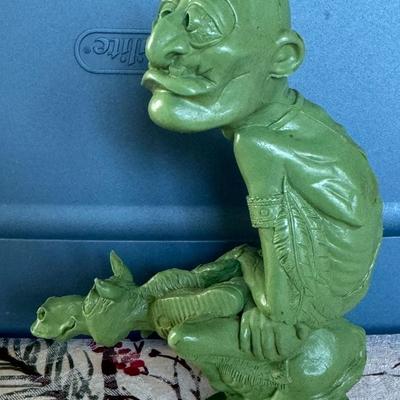
A green plastic figure, which appears to be Chief Lost Teepee from the Marx Nutty Mads series. This figure was originally manufactured in 1963 by the Louis Marx & Co. More details about the figure and series: Nutty Mads were a series of monochromatic, injection-molded plastic toy figures released in 1963-1964 by the Marx Toy Company. They are known for their comically grotesque appearance, which was inspired by the Kustom Kulture graphics of artists like Ed "Big Daddy" Roth and magazine cartoonists like Basil Wolverton and Don Martin. Chief Lost Teepee was part of Series 2 of the Nutty Mads figures. The figures were generally about 6 inches tall and stood on a flat base. The Marx Toy Company produced a similar series of figures called Weird-Ohs, based on Hawk Model kits. 168 / 1369 -
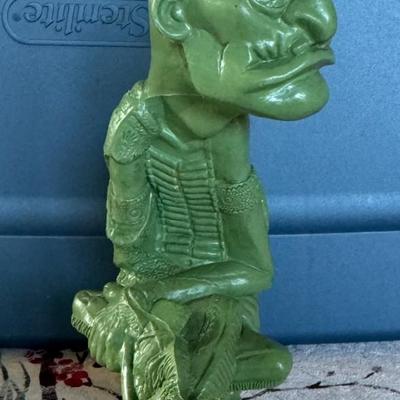
A green plastic figure, which appears to be Chief Lost Teepee from the Marx Nutty Mads series. This figure was originally manufactured in 1963 by the Louis Marx & Co. More details about the figure and series: Nutty Mads were a series of monochromatic, injection-molded plastic toy figures released in 1963-1964 by the Marx Toy Company. They are known for their comically grotesque appearance, which was inspired by the Kustom Kulture graphics of artists like Ed "Big Daddy" Roth and magazine cartoonists like Basil Wolverton and Don Martin. Chief Lost Teepee was part of Series 2 of the Nutty Mads figures. The figures were generally about 6 inches tall and stood on a flat base. The Marx Toy Company produced a similar series of figures called Weird-Ohs, based on Hawk Model kits. 169 / 1369 -
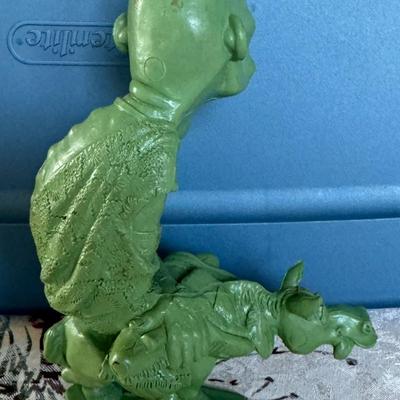
A green plastic figure, which appears to be Chief Lost Teepee from the Marx Nutty Mads series. This figure was originally manufactured in 1963 by the Louis Marx & Co. More details about the figure and series: Nutty Mads were a series of monochromatic, injection-molded plastic toy figures released in 1963-1964 by the Marx Toy Company. They are known for their comically grotesque appearance, which was inspired by the Kustom Kulture graphics of artists like Ed "Big Daddy" Roth and magazine cartoonists like Basil Wolverton and Don Martin. Chief Lost Teepee was part of Series 2 of the Nutty Mads figures. The figures were generally about 6 inches tall and stood on a flat base. The Marx Toy Company produced a similar series of figures called Weird-Ohs, based on Hawk Model kits. 170 / 1369 -
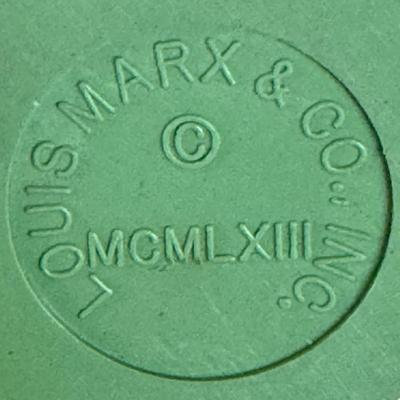
A green plastic figure, which appears to be Chief Lost Teepee from the Marx Nutty Mads series. This figure was originally manufactured in 1963 by the Louis Marx & Co. More details about the figure and series: Nutty Mads were a series of monochromatic, injection-molded plastic toy figures released in 1963-1964 by the Marx Toy Company. They are known for their comically grotesque appearance, which was inspired by the Kustom Kulture graphics of artists like Ed "Big Daddy" Roth and magazine cartoonists like Basil Wolverton and Don Martin. Chief Lost Teepee was part of Series 2 of the Nutty Mads figures. The figures were generally about 6 inches tall and stood on a flat base. The Marx Toy Company produced a similar series of figures called Weird-Ohs, based on Hawk Model kits. 171 / 1369 -
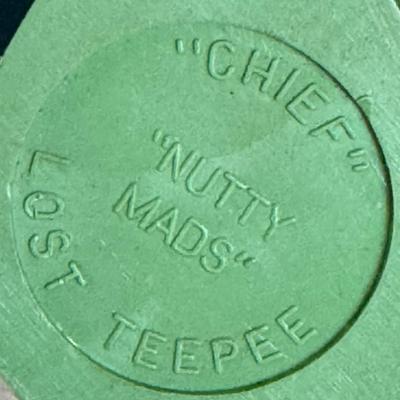
A green plastic figure, which appears to be Chief Lost Teepee from the Marx Nutty Mads series. This figure was originally manufactured in 1963 by the Louis Marx & Co. More details about the figure and series: Nutty Mads were a series of monochromatic, injection-molded plastic toy figures released in 1963-1964 by the Marx Toy Company. They are known for their comically grotesque appearance, which was inspired by the Kustom Kulture graphics of artists like Ed "Big Daddy" Roth and magazine cartoonists like Basil Wolverton and Don Martin. Chief Lost Teepee was part of Series 2 of the Nutty Mads figures. The figures were generally about 6 inches tall and stood on a flat base. The Marx Toy Company produced a similar series of figures called Weird-Ohs, based on Hawk Model kits. 172 / 1369 -
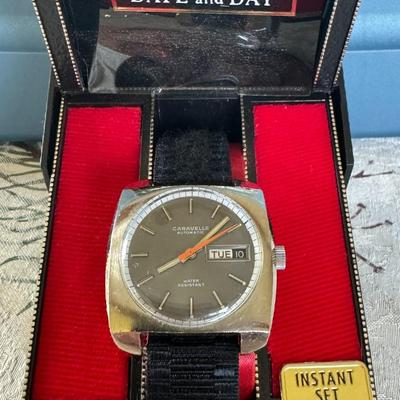
Vintage Caravelle by Bulova watch with a "Date and Day" feature. The watch dial displays "TUE 10" and "RESISTANT," along with the Caravelle logo. It's presented in a black box with red lining that highlights the watch and the "DATE and DAY" and "INSTANT SET" functionalities. Vintage Caravelle watches, known for their combination of style and affordability, are a popular choice among collectors and enthusiasts. Setting the Date and Day: To set the calendar on a Caravelle by Bulova watch, you need to pull the crown out to the first click position. Turning the crown counterclockwise sets the date. Turning the crown clockwise sets the day of the week. After setting, push the crown back to its normal position. Note: The calendar needs to be reset at the beginning of each month as it does not change automatically. 173 / 1369 -
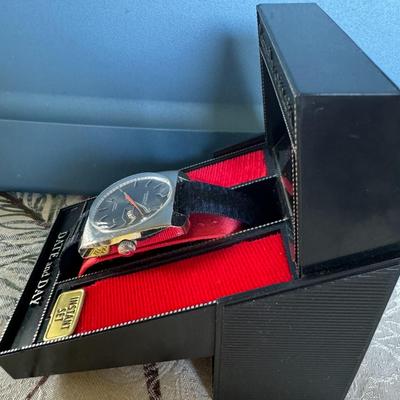
Vintage Caravelle by Bulova watch with a "Date and Day" feature. The watch dial displays "TUE 10" and "RESISTANT," along with the Caravelle logo. It's presented in a black box with red lining that highlights the watch and the "DATE and DAY" and "INSTANT SET" functionalities. Vintage Caravelle watches, known for their combination of style and affordability, are a popular choice among collectors and enthusiasts. Setting the Date and Day: To set the calendar on a Caravelle by Bulova watch, you need to pull the crown out to the first click position. Turning the crown counterclockwise sets the date. Turning the crown clockwise sets the day of the week. After setting, push the crown back to its normal position. Note: The calendar needs to be reset at the beginning of each month as it does not change automatically. 174 / 1369 -
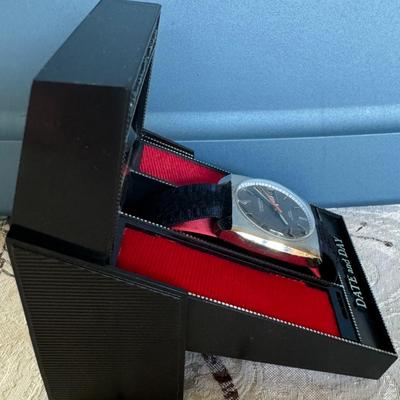
Vintage Caravelle by Bulova watch with a "Date and Day" feature. The watch dial displays "TUE 10" and "RESISTANT," along with the Caravelle logo. It's presented in a black box with red lining that highlights the watch and the "DATE and DAY" and "INSTANT SET" functionalities. Vintage Caravelle watches, known for their combination of style and affordability, are a popular choice among collectors and enthusiasts. Setting the Date and Day: To set the calendar on a Caravelle by Bulova watch, you need to pull the crown out to the first click position. Turning the crown counterclockwise sets the date. Turning the crown clockwise sets the day of the week. After setting, push the crown back to its normal position. Note: The calendar needs to be reset at the beginning of each month as it does not change automatically. 175 / 1369 -
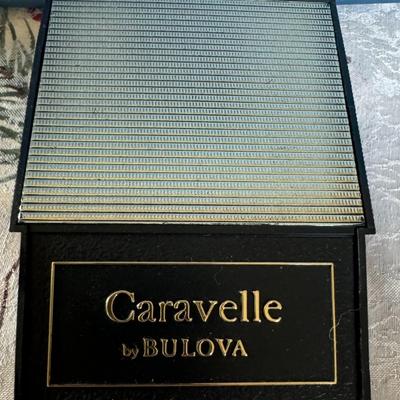
Vintage Caravelle by Bulova watch with a "Date and Day" feature. The watch dial displays "TUE 10" and "RESISTANT," along with the Caravelle logo. It's presented in a black box with red lining that highlights the watch and the "DATE and DAY" and "INSTANT SET" functionalities. Vintage Caravelle watches, known for their combination of style and affordability, are a popular choice among collectors and enthusiasts. Setting the Date and Day: To set the calendar on a Caravelle by Bulova watch, you need to pull the crown out to the first click position. Turning the crown counterclockwise sets the date. Turning the crown clockwise sets the day of the week. After setting, push the crown back to its normal position. Note: The calendar needs to be reset at the beginning of each month as it does not change automatically. 176 / 1369 -
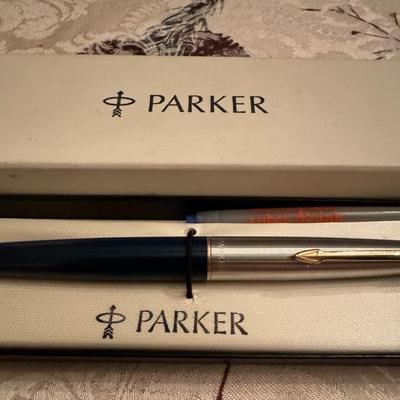
Parker 45 GT fountain pen in a box. About the Parker 45 GT: Introduction and History: The Parker 45 was introduced in the early 1960s as a less expensive option compared to the Parker 51. It was Parker's first cartridge/converter pen and proved to be very popular, enjoying a long production run that ended in 2008. The "45" in the name is believed to reference the Colt .45 handgun. GT Variant: "GT" stands for Gold Trim, referring to the gold-plated accents on the pen, such as the clip and clutch ring. Features: The Parker 45 is known for being reliable and generally well-built. Filling System: It can be filled using either Parker ink cartridges or a converter to use bottled ink. The pen in the image includes a converter, according to the description of a similar pen set. Nib: The nib unit (nib, feed, and collar) can be easily unscrewed for cleaning or swapping with different nib sizes. 14k gold and steel nibs were available. Collector's Item: Parker 45s, particularly the early models from the 1960s and 1970s, are considered collectible due to their history and wide variety of styles and finishes. 185 / 1369 -
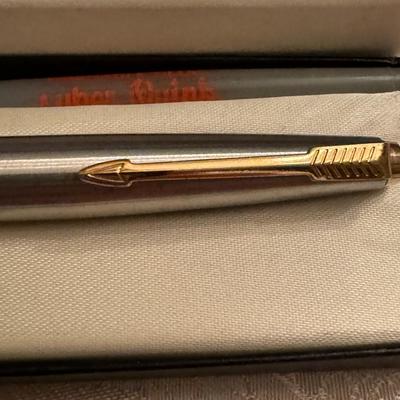
Parker 45 GT fountain pen in a box. About the Parker 45 GT: Introduction and History: The Parker 45 was introduced in the early 1960s as a less expensive option compared to the Parker 51. It was Parker's first cartridge/converter pen and proved to be very popular, enjoying a long production run that ended in 2008. The "45" in the name is believed to reference the Colt .45 handgun. GT Variant: "GT" stands for Gold Trim, referring to the gold-plated accents on the pen, such as the clip and clutch ring. Features: The Parker 45 is known for being reliable and generally well-built. Filling System: It can be filled using either Parker ink cartridges or a converter to use bottled ink. The pen in the image includes a converter, according to the description of a similar pen set. Nib: The nib unit (nib, feed, and collar) can be easily unscrewed for cleaning or swapping with different nib sizes. 14k gold and steel nibs were available. Collector's Item: Parker 45s, particularly the early models from the 1960s and 1970s, are considered collectible due to their history and wide variety of styles and finishes. 186 / 1369 -
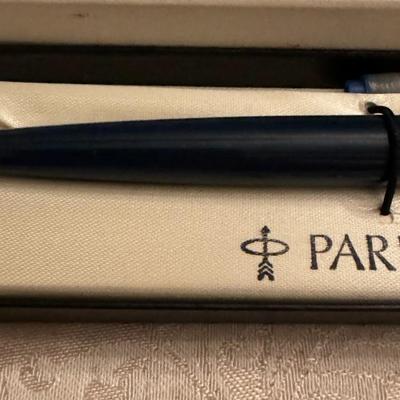
Parker 45 GT fountain pen in a box. About the Parker 45 GT: Introduction and History: The Parker 45 was introduced in the early 1960s as a less expensive option compared to the Parker 51. It was Parker's first cartridge/converter pen and proved to be very popular, enjoying a long production run that ended in 2008. The "45" in the name is believed to reference the Colt .45 handgun. GT Variant: "GT" stands for Gold Trim, referring to the gold-plated accents on the pen, such as the clip and clutch ring. Features: The Parker 45 is known for being reliable and generally well-built. Filling System: It can be filled using either Parker ink cartridges or a converter to use bottled ink. The pen in the image includes a converter, according to the description of a similar pen set. Nib: The nib unit (nib, feed, and collar) can be easily unscrewed for cleaning or swapping with different nib sizes. 14k gold and steel nibs were available. Collector's Item: Parker 45s, particularly the early models from the 1960s and 1970s, are considered collectible due to their history and wide variety of styles and finishes. 187 / 1369 -
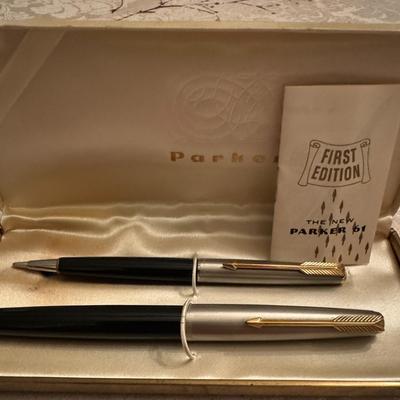
Parker 61 fountain pen and a matching ballpoint pen in a presentation box. Based on the accompanying paperwork that says "First Edition", this appears to be a Parker 61 First Edition set. The Parker 61 was first test marketed in 1953 and introduced in 1956. The "First Edition" pens, like the one in the image, likely featured specific design elements or promotional materials that differentiated them from later models. The Parker 61 is notable for its innovative capillary filling system, which allowed the pen to be filled simply by immersing the end of the barrel in ink. This set seems to include a fountain pen with this unique filling system and a matching ballpoint pen. 188 / 1369 -
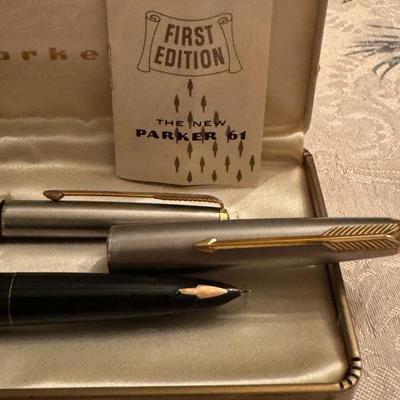
Parker 61 fountain pen and a matching ballpoint pen in a presentation box. Based on the accompanying paperwork that says "First Edition", this appears to be a Parker 61 First Edition set. The Parker 61 was first test marketed in 1953 and introduced in 1956. The "First Edition" pens, like the one in the image, likely featured specific design elements or promotional materials that differentiated them from later models. The Parker 61 is notable for its innovative capillary filling system, which allowed the pen to be filled simply by immersing the end of the barrel in ink. This set seems to include a fountain pen with this unique filling system and a matching ballpoint pen. 189 / 1369 -
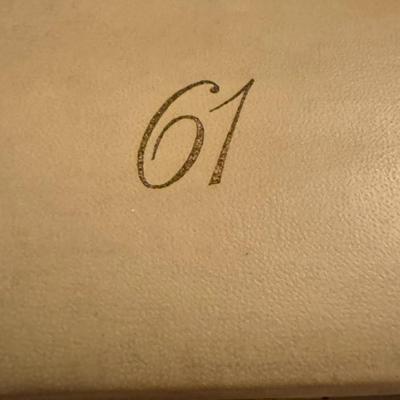
Parker 61 fountain pen and a matching ballpoint pen in a presentation box. Based on the accompanying paperwork that says "First Edition", this appears to be a Parker 61 First Edition set. The Parker 61 was first test marketed in 1953 and introduced in 1956. The "First Edition" pens, like the one in the image, likely featured specific design elements or promotional materials that differentiated them from later models. The Parker 61 is notable for its innovative capillary filling system, which allowed the pen to be filled simply by immersing the end of the barrel in ink. This set seems to include a fountain pen with this unique filling system and a matching ballpoint pen. 190 / 1369 -
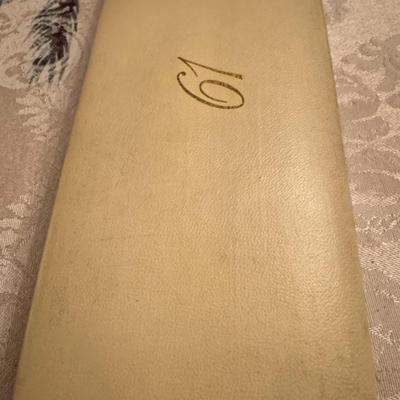
Parker 61 fountain pen and a matching ballpoint pen in a presentation box. Based on the accompanying paperwork that says "First Edition", this appears to be a Parker 61 First Edition set. The Parker 61 was first test marketed in 1953 and introduced in 1956. The "First Edition" pens, like the one in the image, likely featured specific design elements or promotional materials that differentiated them from later models. The Parker 61 is notable for its innovative capillary filling system, which allowed the pen to be filled simply by immersing the end of the barrel in ink. This set seems to include a fountain pen with this unique filling system and a matching ballpoint pen. 191 / 1369 -
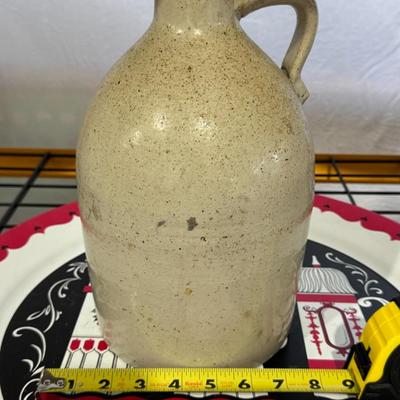
primitive stoneware jug, likely an antique piece used historically for storing various liquids like water, milk, or spirits. Here's more information about this type of jug: Material and Glaze: This jug is made of stoneware, a durable and waterproof type of pottery fired at high temperatures. Its slightly textured, often shiny surface is characteristic of a salt glaze, created by introducing salt into the kiln during firing, which reacts with the clay to form a glassy coating. Form and Era: The ovoid, or "beehive," shape seen in the image was common for American stoneware jugs from the 18th and 19th centuries, particularly in the early to mid-1800s. Utilitarian Purpose: These jugs were essential household items before the widespread use of refrigeration, serving as containers for liquids, and sometimes even for butter or other food items. 192 / 1369 -
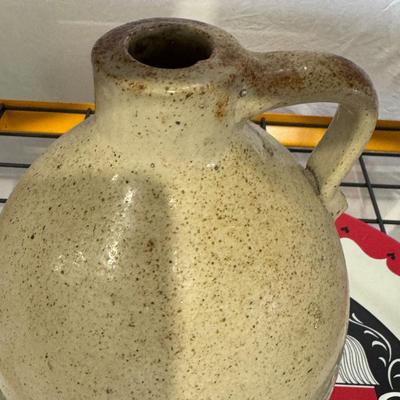
primitive stoneware jug, likely an antique piece used historically for storing various liquids like water, milk, or spirits. Here's more information about this type of jug: Material and Glaze: This jug is made of stoneware, a durable and waterproof type of pottery fired at high temperatures. Its slightly textured, often shiny surface is characteristic of a salt glaze, created by introducing salt into the kiln during firing, which reacts with the clay to form a glassy coating. Form and Era: The ovoid, or "beehive," shape seen in the image was common for American stoneware jugs from the 18th and 19th centuries, particularly in the early to mid-1800s. Utilitarian Purpose: These jugs were essential household items before the widespread use of refrigeration, serving as containers for liquids, and sometimes even for butter or other food items. 193 / 1369 -
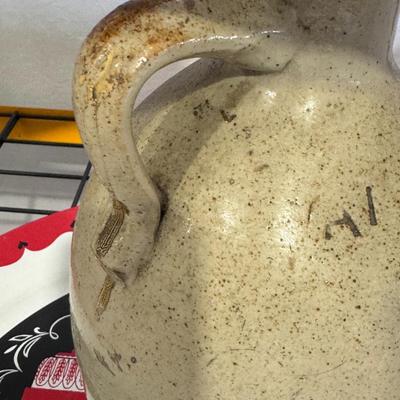
primitive stoneware jug, likely an antique piece used historically for storing various liquids like water, milk, or spirits. Here's more information about this type of jug: Material and Glaze: This jug is made of stoneware, a durable and waterproof type of pottery fired at high temperatures. Its slightly textured, often shiny surface is characteristic of a salt glaze, created by introducing salt into the kiln during firing, which reacts with the clay to form a glassy coating. Form and Era: The ovoid, or "beehive," shape seen in the image was common for American stoneware jugs from the 18th and 19th centuries, particularly in the early to mid-1800s. Utilitarian Purpose: These jugs were essential household items before the widespread use of refrigeration, serving as containers for liquids, and sometimes even for butter or other food items. 194 / 1369 -
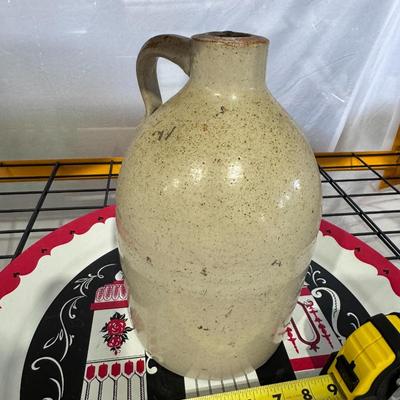
primitive stoneware jug, likely an antique piece used historically for storing various liquids like water, milk, or spirits. Here's more information about this type of jug: Material and Glaze: This jug is made of stoneware, a durable and waterproof type of pottery fired at high temperatures. Its slightly textured, often shiny surface is characteristic of a salt glaze, created by introducing salt into the kiln during firing, which reacts with the clay to form a glassy coating. Form and Era: The ovoid, or "beehive," shape seen in the image was common for American stoneware jugs from the 18th and 19th centuries, particularly in the early to mid-1800s. Utilitarian Purpose: These jugs were essential household items before the widespread use of refrigeration, serving as containers for liquids, and sometimes even for butter or other food items. 195 / 1369 -
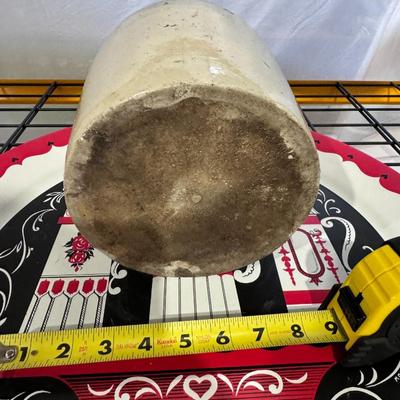
primitive stoneware jug, likely an antique piece used historically for storing various liquids like water, milk, or spirits. Here's more information about this type of jug: Material and Glaze: This jug is made of stoneware, a durable and waterproof type of pottery fired at high temperatures. Its slightly textured, often shiny surface is characteristic of a salt glaze, created by introducing salt into the kiln during firing, which reacts with the clay to form a glassy coating. Form and Era: The ovoid, or "beehive," shape seen in the image was common for American stoneware jugs from the 18th and 19th centuries, particularly in the early to mid-1800s. Utilitarian Purpose: These jugs were essential household items before the widespread use of refrigeration, serving as containers for liquids, and sometimes even for butter or other food items. 196 / 1369 -
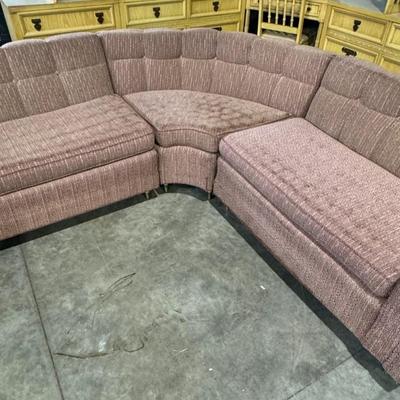
MCM sectional comes from a smoke free and Pet free home. One owner since new. Fabric is not crunchy and sits well. Does not have any "off odors.. Slight variations in fabric color due to age, sun and use. Overall condition of fabric is an 8.5 out of 10. Structure / frame is sound Sectional consists of 3 pieces 18" to top of seat x 34" deep x 28" to top of back The two outer sections are 50" wide with center curved piece 55" wide total 155" 197 / 1369 -
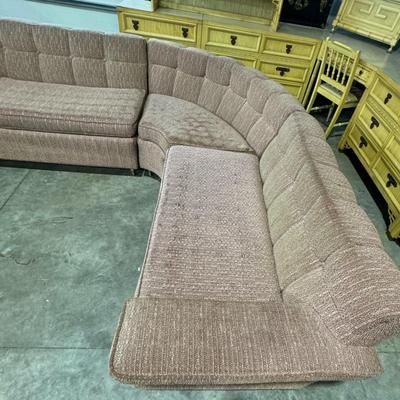
MCM sectional comes from a smoke free and Pet free home. One owner since new. Fabric is not crunchy and sits well. Does not have any "off odors.. Slight variations in fabric color due to age, sun and use. Overall condition of fabric is an 8.5 out of 10. Structure / frame is sound Sectional consists of 3 pieces 18" to top of seat x 34" deep x 28" to top of back The two outer sections are 50" wide with center curved piece 55" wide total 155" 198 / 1369 -
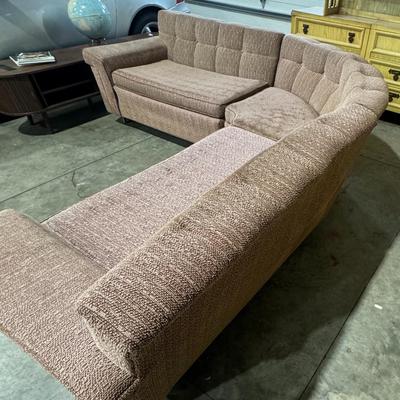
MCM sectional comes from a smoke free and Pet free home. One owner since new. Fabric is not crunchy and sits well. Does not have any "off odors.. Slight variations in fabric color due to age, sun and use. Overall condition of fabric is an 8.5 out of 10. Structure / frame is sound Sectional consists of 3 pieces 18" to top of seat x 34" deep x 28" to top of back The two outer sections are 50" wide with center curved piece 55" wide total 155" 199 / 1369 -
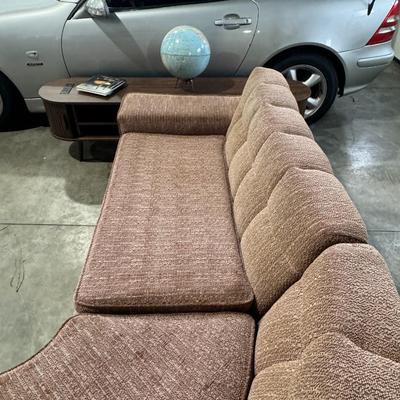
MCM sectional comes from a smoke free and Pet free home. One owner since new. Fabric is not crunchy and sits well. Does not have any "off odors.. Slight variations in fabric color due to age, sun and use. Overall condition of fabric is an 8.5 out of 10. Structure / frame is sound Sectional consists of 3 pieces 18" to top of seat x 34" deep x 28" to top of back The two outer sections are 50" wide with center curved piece 55" wide total 155" 200 / 1369
Photos 101 - 200 of 1369
Per page:
